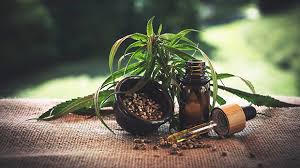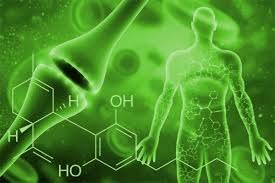Do you remember looking at your hands? I actually looked at your hands.
Although you might not think so, the classic Doonesbury cartoon suggests that people high on cannabis can find mundane objects more interesting than they normally would.
How is it possible that a plant that first appeared on the Tibetan Plateau can alter our perceptions of reality? Cannabinoids are a group of compounds that is responsible for the secret to cannabis’ ability to alter perceptions. Although cannabis plants can produce 140 kinds of cannabinoids from their plants, the one responsible for feeling high is the most important. It’s called tetrahydrocannabinol, or THC.
According to Daniele Piomelli (a professor of anatomy and neurobiology at the University of California Irvine School of Medicine), THC “goes in your lungs and gets…absorbed into the blood.” The liver is slower for edibles, as enzymes convert THC to a different compound. This takes longer to affect people’s perceptions of reality.
Piomelli stated that THC inhaled quickly “reaches quite high levels.” The circulatory system transports THC molecules to every part of the body within 20 minutes. It can also be carried to the brain to alter the chemistry.
Kelly Drew, a professor of biochemistry and chemistry at the University of Alaska Fairbanks, stated that “from the lungs it’s an almost straight shot to the brain.”
THC molecules that cross the blood-brain barrier will fit into receptors that normally receive compounds called Endocannabinoids. These are substances that the body makes itself. Piomelli also directs the Study of Cannabis (UC Irvine).
Piomelli stated that the endocannabinoid is the most widespread, diffused, and important modulatory system of the brain as it controls the release of almost all neurotransmitters. Neurotransmitters, also known as neurotransmitters, are molecules brain cells use to communicate. Each neuron transmits information to another by sending neurotransmitters such as serotonin or dopamine into an infinitesimal gap. This gap separates the neuron from its counterpart. The synapse is the name of this gap.
Drew explained that the neuron at the receiving end is postsynaptic. It “decides whether it fires based on the input it gets,” Drew said to Live Science. These neural signals are transmitted through complex circuits of neural connections, which function on a huge scale. There are approximately 85 million neurons and about 100 billion connections between them.
Piomelli stated that the presynaptic nerve sends neurotransmitters through the synapse to the postsynaptic neural. The presynaptic nerve can also receive information. Piomelli explained that a postsynaptic nerve can fire and send a message to the synapse saying, “The neuron I came from has been activated.” It will stop sending neurotransmitters. This “stop” message is sent in the form of cannabinoid 1 (CB1) endocannabinoids.
“Like a Sledgehammer”
Drew explained that THC enters the brain and diffuses into the synapses, where it “activates CB1 receptors”. Although THC does not cause an extreme response as synthetic cannabinoids like K2 and spice, it can “turn up” the volume and increase the chances that the presynaptic neurons it affects will temporarily stop transmitting neurotransmitters.
Piomelli stated that the high is a simple phenomenon. “THC is like a sledgehammer,” floods the endocannabinoid with signals that postsynaptic neurons don’t send. Presynaptic neurotransmitters are sent to the brain by presynaptic cells. This alters the normal flow of information between neurons and causes a high.
However, scientists are still trying to figure out what exactly happens during this euphoria.
This is partly because it is difficult to study marijuana in the United States. Researchers have discovered that THC temporarily “unplugs” the default mode network. This brain network allows us to daydream and think about the future and the past. Our brains can be focused on a task to let our executive function control.
Researchers aren’t sure how THC affects the network, but there is evidence. Piomelli stated that there are cannabinoid receptors in the brain all over, including “areas that constitute key nodes of [default mode network]”, Piomelli said that THC could “deactivate the [default mode] network by combining those receptors”, but that it is also possible that THC has an indirect effect that involves cannabinoid-receptors in other parts of the brain.
Scientists are still trying to discover the mechanism that makes a person feel high. However, some evidence suggests this effect on the default network is an important piece of the puzzle.
Piomelli stated that unplugging the default network “takes you into a mental space where the function and value of the things you experience is less important than their actual existence: your hands are not just something we use to touch or grab, but something with inner existence as well as intrinsic value.” Psychedelics, such as LSD or dried psilocybin-containing mushrooms, do the same.
People can experience different highs. Piomelli stated that the feeling of being ‘connected’ to ordinary objects, which we all see every day, isn’t universal but can happen when high doses of THC-containing cannabis are taken.
THC does not only affect the default mode network. According to Nature’s 2017 study, THC may flood the brain with dopamine. This is the brain’s reward signal. The study also found that long-term dopamine effects may be hampered by it. This may partially explain the high and puts cannabis alongside other drugs to feel pleasure.
Drew stated that every drug with rewarding properties affects the system.
Aftereffects
Although the effects of cannabis smoking or inhaling last only a few hours, edibles can take as long to begin affecting users. Although cannabis isn’t as dangerous as it was believed to be, it can still pose a risk when used. First, although cannabis is legal in certain states for medical and recreational use, it is still illegal in many other parts of the country.
It would help if you also remembered that cannabis could be a powerful pharmacological substance. Pregnant women should not use cannabis. Cannabis can cross the placenta. Piomelli also said that excessive use during teen years could be dangerous. In particular, cannabis and synthetic cannabinoids such as spice can worsen psychosis. Drew stated that cannabis should be avoided by people who are most at risk.
Infrequent users of cannabis may experience impairments in their ability to drive. Drew advised that users should not drive after they have smoked cannabis.
The THC will eventually leave the brain. The profusion of blood that brought THC to the brain will transport it to the liver, which will be destroyed.
You won’t believe it, but your hands were the same throughout.



